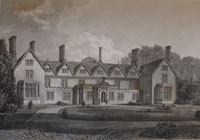
Hardwick House c1830
Quick links on this page
King Edmund's charter 945
R Drury buys Bokenhams-Hawsted 1463
Wm Drury gets Hencote 1553
Queen at Hawsted 1578
Drury buys Hardwick 1610
Cullum buys Hawsted and Hardwick 1656
Cullum resides Hardwick 1730
Warren's map 1791
John Gage on Thingoe 1838
Foot of page 1913
|
History of
Hardwick Heath, Hardwick Park and The Hardwick Estate
Before the Great War
|
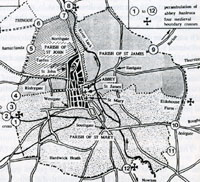
Banleuca Boundaries by C R Hart
|
|
945
|
According to an Anglo-Saxon Charter, in 945 King Edmund gave up his royal rights to taxes and all feudal dues and fees in the area of Bury St Edmunds for about one mile around St Edmund's shrine.
In 1968 P H Sawyer produced a catalogue called "Anglo-Saxon Charters: an Annotated List and Bibliography". This replaced earlier lists by J M Kemble, published in 1839-1848, and W Birch in 1885 to 1893. This charter of 945 is now catalogued as S 507, and further details can be seen by clicking on that reference.
Dr Cyril Hart largely accepted the authenticity of this charter and other recent research has described the content of this charter as "worthy of favourable reconsideration."
Dr Cyril Hart has produced the attached map which plots his interpretations of these landmarks. Such a boundary description is known as a "perambulation", and was the normal method of describing a location at this time.
The area now known as Hardwick Heath was included in this grant of land, and is visible in Dr Hart's map. The adjacent farm of Hencote was also held by the abbey.
|
|
980
|
Aelfwine gave 'Lawshela, Halistede and Ryseby' to Ramsey Abbey. Halistede is the name of Hawsted at this time.
|
|
1020
|
Aelfwine was Bishop of Ely, and it was him who masterminded for Cnut the establishment of Benedictine rule at Bury in 1020. He sent the first contingent of Benedictines to Bury from Ely and from Holm. Leofstan was one of those monks
|
|
1044
|
In a deed dated between 1044 and 1065 in the time of Edward the Confessor, Leofstan, the steward of Abbot Leofstan and his relative Stannard, gave Welnetham and Hawsted to the Abbey. This grant was numbered 364 by Cyril Hart, but no actual will is known to exist. Leofstan was the second Abbot of Bury, ruling from 1044 to 1065. It may be that his relationship with the Bishop of Ely allowed them to annexe Hawsted from Ramsey to Bury.
|
|
1086
|
In the Domesday Book Hawsted is written as Haldsteda and Hersteda. By this time Hawsted was one of the possessions of Bury St Edmunds abbey. However, Odo, Albold and Peter, and Agnet held land from the abbot which they could buy and sell, but the sake and soke and commendation continued to belong to St Edmund.
Hardwick did not appear in the Domesday Book.
|
|
1148
|
In the reign of King Stephen, (from 1135-1154) Cullum believed that the first mention of Hardwick was made in a grant from King Stephen to Abbot Ording of Hardwick. However, John Gage believed that this document was merely a confirmation of an earlier right. Ording was temporary abbot in 1138, and then from 1148 to 1157.
In the later Register of Werketone the cellerer was recorded as the tenant of Hardwick Heath and controlled the flocks and pasturage of that area. The cellerer had 400 sheep in this area. There were also 132 acres under cultivation. Certain parcels in Nechelesmere, Waterpit, Hokewell and Mill Wongs were exempt from tithes.
|
|
1242
|
Clive Paine records that by 1242 Hawsted was being spelled 'Haustede.'
|
|
1272
|
A survey of Hawsted made in the last year of Henry III mentions two manors in the village. These were the Manor of Hawsted hall and Talmache's, also apparently known later as Bokenham's. Cullum wrote (page 102) that in his time, (1784) the full style of Hawsted Manor was "The Manor of Hawsted Hall with Bokenhams".
|
|
1286
|
A survey of the abbot's lands in 1286 shows the manor of Hawsted held by Sir Thomas Eustace.
The second manor was held by Sir William Talmache, probably from about 1281.
|
|
1359
|
Sir William Clopton purchased Hawsted Manor, and other lands in that vill. At this time Hawsted Manor was 662 acres generating £11 in rents of which £2 had to be paid to the abbot.
|
|
1392
|
The Talmache manor became called Bokenham's when Alice Talmache married William Bokenham of Great Livermere.
|
|
1463
|
The manor of Bokenham's alias Talmache was sold to Roger Drury in 1463
|
|
1505
|
In the 20 Henry VII (1505) Sir William Clopton sold the manor of Hawsted Hall to Sir Robert Drury. A previous Roger Drury had already held Bokenham's since 3 Edward IV (1463). The two manors in Hawsted were now both owned by the Drury family.
The main manor remained Bokenhams and it was there that the Drurys built or enlarged their "Place in Hawstead"
|
|
1510
|
In about 1510 a licence was obtained to "empark, make chase and crenellate". So their main building at Hawstead dates from this time. This included a square moat lined with bricks and a bridge at the south and a drawbridge to the north
|
|
1546
|
After 1540 King Henry VIII now began to convert the seized properties of the church into cash. The details of each sale were settled by the Court of Augmentations which was responsible for the disposal of former monastic lands for the crown. Nicholas Bacon was Solicitor to the Court of Augmentations from 1537 to 1546, and he had local connections. His father was Robert Bacon, of Drinkstone, Esquire and Sheep-reeve to the Abbey of Bury St. Edmunds.
The manor of Hardwick was granted to Sir Thomas Darcy, who was Lord Darcy of Chiche, (now known as St Osyth's) as part of the monastic disposals, although the exact area is unclear. "All woods....called Hardwycks Wood....50 acres in Bury St Edmunds, Nowton, Stanefield and Gt Horningsherth" were granted to Darcy. Darcy had already owned Horringer Parva since 1540.
Hardwick would then pass through several hands. Hardwick’s next owner was Sir Robert Southwell, Master of the Rolls of the Court of Chancery in 1541-1550. Sir Robert Southwell was granted several manors from Henry the VIII, several of which he sold on. Hardwick was sold to Sir Thomas Goodrick, who in 1597 bequeathed Hardwick Lodge to his wife. The estate was then sold to Thomas Stanton of Bury.
|
|
1553
|
According to Cullum's Hawsted the farm known as Hencote was granted to Sir William Drury by Queen Mary. Cullum reckoned that Hencote "comprehends the unenclosed part of the present farm, (ie Hardwick) which lies within the bounds of Bury." It was thought to derive its name from the hens, chickens, geese, ducks and eggs, pigeons etc anciently paid as rent to the abbey. (Yates, 1805, p175)
|
|
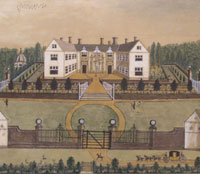
Hawstead Place
|
|
1577
|
At around this time the old manor house called Bokenhams at Hawstead was enlarged and improved by Sir William Drury. The walls were said to be decorated with inlays of glass, so that the house gleamed and glittered by day and by moonlight.
A description of the property was included by Sir John Cullum in his History of Hawstead. It was described as being on an eminence, gently sloping towards the south. The whole formed a quadrangle, 202 by 211 feet, divided into two sections.
The first courtyard consisted on three sides of barns, stables, a mill house, slaughter house, blacksmiths shop, and various other offices. In the fashion of the time, these working buildings were a little further away from the great house than they would have been in the time of Henry VIII. The main house could only be approached through this Outer Court.
The rear section of the whole enclosure contained the mansion house, standing higher than the other buildings and divided from them by a moat, and surrounded by a fine wide terrace. This Inner Court was an area of 58 feet square.
The statue of Hercules was sited in front of the main entrance and would have been the first thing to be seen upon approaching the House. It can be seen by clicking on the thumbnail shown here.
|
|
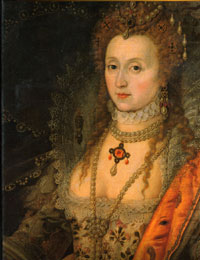
Queen Elizabeth I
|
|
1578
|
Queen Elizabeth I had reigned for twenty years, and was in the habit of undertaking Royal Progresses through the kingdom. This kept her in touch with people and ideas, and allowed her to favour the compliant and snub the disaffected or fanatical adherents to religious views of which she disapproved.
At home, the major issue was the refusal of Catholics to accept the official Protestant religion. This issue was made more dangerous by the presence of Mary Queen of Scots under house arrest in Derbyshire. She could at any time become the focus of a Catholic uprising. East Anglia was prosperous and densely populated, and Norfolk and Suffolk retained a number of important Catholic families.
In May the first ideas were being discussed at Court. In mid June, Thetford and Norwich were given official notice to expect the Queen in August.
On Tuesday, 5th August, the Queen journeyed northwards to Lawshall Hall, the home of Henry Drury , where she dined, but did not stay overnight.
Henry Drury was a Catholic, and although nothing happened while the Queen was at his home, he would later be arrested for his faith.
Later on that evening of the 5th August, the Queen rode on into Bury St Edmunds.
|
|
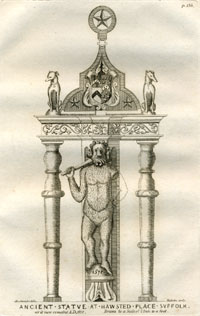
Hercules
|
|
blank |
During the stay at Bury St Edmunds, the Queen rode out to visit the newly rebuilt manor house of Sir William Drury at Hawstead Place. This is generally accepted to be on the site of the old Bokenham's manor house. Sir William Drury was nephew to Henry Drury of Lawshall, but was not a Catholic, and thus found greater favour from the Queen. Sir William Drury was well known to the Queen, having married Elizabeth Stafford, one of the ladies of the Bedchamber.
In honour of the Queen's visit, a stone statue was carved of a naked man with a large club. This may have been intended to be Hercules, a popular theme at this time. The illustration here showing the statue in a loincloth is almost certainly not as it originally appeared. It originally formed part of a stone fountain in which the flow of water made it appear that it was Hercules passing water. This statue was taken with the Drurys when they moved to Hardwick in the 17th century, but now stands at Hawstead Place Farm today.
The Queen was said to have dropped her fan into the moat at Hawstead. As Sir William had 2,000 acres enclosed for a Deer Park, the Queen went hunting there, and then enjoyed a "costly and delicate dinner." But even this outing had been carefully orchestrated by Anthony Wingfield, of the Court, who had spent two days at Hawstead setting up the Dining Chamber, and Charles Smythe, who came for a day to assist the arrangements.
The Queen had stayed an unusual length of time at Bury, and left that town on Saturday 9th August, heading for Mr Rookwood's house at Euston for the weekend.
|
|
1589
|
In 1589 Sir William Drury of Hawstead was a Colonel in France, and was killed in a duel with Colonel Sir John Burroughs over what Sir John Cullum called "a foolish quarrel about precedency". His body was brought home to be buried in Hawstead Church "where a fine marble bust of him in armour still remains."
Following Drury's demise, Sir William Waldegrave, Sir John Higham, Sir Nicholas Bacon and Sir William Spring were directed by the Queen to undertake the commission for the inquisition after his death to enquire into the annual value of his estates. The enquiry found, amongst other things, that "Roger Reve of Bury, gent, holds, by lease, (from Drury - ed) the profits of the fayres and markets in Bury, at £36 a year's rent, 40s deductions." At this date it therefore appears that the fairs and markets in Bury had been leased to Sir William Drury of Hawstead Place from the Crown, and that he had sub-leased these rights to Reve.
In 1510 Sir Robert Drury had gained permission to empark his estates. However, with the refurbishment of Buckenhams to become Hawstead Place, it seems that a new park was created around the estate in the 1580s. One set of particulars from the depositions after the enquiry into his will, was as follows:
"The new park is unletten, worth about 20 marks yearlie, besides profits of deer and conies. Another person valued the park very differently, unless he included the profits of the livestock in it: he said the new park is not very much charged with deer and conies; and worth yearlie £50."
Sir William Drury was succeeded by his son, Robert Drury, who was a friend of the poet John Donne. Donne would write Drury's daughter's epitaph and memorial elegies after her death in 1610.
|
|
1592
|
In 1592 Sir Robert Drury (1575-1615) married Ann Bacon, (1572-1624) an educated and well to do woman. Lady Anne was the granddaughter of Sir Nicholas Bacon, the Lord Keeper of the Great Seal of England, and had grown up in a family that believed in educating their daughters. She had been given a generous dowry of £1,600 from her father on her wedding to Sir Robert Drury and she was the older sister of the court amateur painter Sir Nathaniel Bacon. At this time Nathaniel Bacon was considered to be England’s finest amateur artist.
For Lady Drury, despite beginning her married life in privileged, and hopefully optimistic circumstances, she suffered loss and lneliness when she lost her first daughter, Dorothy aged 4 in 1597 and her second daughter, Elizabeth, aged 14 in 1610.
|
|
1601
|
In 1601 Joseph Hall was presented to the living of Hawstead by Sir Robert Drury. Joseph Hall was born at Bristow Park, Ashby-de-la-Zouch, on 1 July 1574. The expense of his education at Cambridge university was partly borne by his uncle, Edmund Sleigh. He was elected scholar and afterwards fellow of Emmanuel College (1595), graduating B.A. in 1592 and M.A. in 1596. He became Bachelor of Divinity in 1603. He obtained a high reputation in the university for scholarship, and read the public rhetoric lecture in the schools for two years with much credit.
Hall would publish many books, and eventually would be made Bishop of Exeter in 1627 and Bishop of Norwich in 1641.
Two of his writings were published as "Three Centuries of Meditations and Vowes, Divine and Morall" (1606, 1607, 1609), edited by Charles Sayle, and "The Arte of Divine Meditation". (1607)
He remained at Hawstead only until 1605, but his preachings on meditations are thought to have had a profound effect upon Lady Ann Drury, and possibly inspired her to consider making her own meditative space or "closet".
|
|
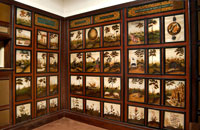
Lady Ann's Painted Closet
|
|
1603
|
Around this time Lady Ann Drury probably began thinking about her project which was later known as her Painted Closet. Protestant ideals were against depictions of the holy family or the saints that had adorned churches before the Reformation. Prayer and contemplation was now to be centred around "emblems", as described in books such as ‘A Choice of Emblemes’ (1586) by Geffrey Whitney and ‘Heroicall Devises’ (1591) by Claude Paradin. There was also a Jacobean fashion for symbolic decoration with designs and text covering the walls of domestic interiors.
At Hawstead Place Lady Drury selected a small room, study or closet wherein she could make her devotions assisted by a series of painted panels, each one devoted to a theme or "emblem" of devotional significance.
In his History of Hawstead and Hardwick, Cullum devoted several pages to the description and interpretation of these panels, but made no reference to a possible artist or artists. Lady Ann's brother was a well known amateur artist, and the practice of painting would have been well known to Lady Ann. It is therefore becoming accepted that Lady Ann Drury herself may well have executed these paintings possibly over a period of years to 1615.
In 1924 the panels were purchased by the Ipswich Borough Council and can now be seen in the Christchurch Mansion Museum there. You can also find illustrations from Cullum's Book as well as photographs from the Christchurch Display by clicking here:
Lady Ann Drury's Painted Closet
|
|
1610
|
Sir Robert Drury, the last male representative of the Hawstead branch of this widespread Suffolk family, purchased “the hereditaments called Herdwick or Hardwick wood with the buildings thereon” for £1100 on 19th April 1610 from Thomas Stanton.
Drury had probably financed the purchase by his sale of his market rights to the corporation at Bury for £2000.
Thus began the association of the Drury family with Hardwick which lasted until 1656. Drury now proceeded to build the mansion, later to become known as Hardwick House. He would remove many of his treasures from his old estate at Hawstead Place, and install them in the new Hardwick House.
Hardwick, Hencote and Hawsted were now in common Drury ownership.
|
|
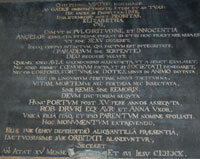
Epitaph of Elizabeth Drury
|
|
blank |
In 1610 tragedy struck the Drury family, as Robert's only surviving child, Elizabeth, died at the age of 14. The poet John Donne wrote her epitaph, which is on her tomb in Hawstead Church. John Donne had probably been known to Drury for some time, but it was this elegy which made them friends.
|
|
1611
|
At around this time it seems that Sir Robert Drury decided to leave Hawstead Place and move to Hardwick House, perhaps to have a fresh start after his family loss. The dairy and park at Hawstead were let out on a three year term, and he founded a charity, which was worth £52 a year.
|
|
1612
|
The date of around 1612 is thought to mark the completion of the new Hardwick House by Sir Robert Drury. Like many such great houses, it seems to have incorporated features from an earlier building on the site. In this case it is believed to have been the medieval Abbey Lodge. Drury removed 68 painted panels from Hawstead to incorporate into a room later known as the Painted Closet. Possibly this was intended to be for a chapel in the house.
|
|
1613
|
As if to confirm his removal from Hawstead Place to Hardwick House, Sir Robert Drury obtained a license to have divine service read in his new house at Hardwick. Thomas Ridley, the Archbishop of Canterbury, granted the license to include his wife, his servants, and the widows from his newly founded almshouse. Hardwick appears to have now become an extra-parochial district.
|
|
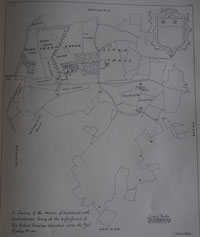
Manor of Hawsted with Buckenhams c1615
|
|
1615
|
Sir Robert Drury died on April 02, 1615. Hawstead Church contains his marble monument and that of his daughter Elizabeth. When Sir Robert Drury died, his estates, including Hardwick and the Grange of Hencote, were divided between his three living sisters. The Hardwick estate came to his sister Frances, the Lady Wray. The plan shown here was possibly commissioned by Sir Robert Drury, but delivered to Lady Wray, as shown in the dedication. This later engraving was made by J Basire and included in John Gage's volume on Thingoe of 1838. It covers the manor of Hawsted with Buckenhams.
North is at the top of this map. (Septentrio refers to Ursa major the stars which dominate the northern sky at night.)
The representation of the line of Drury of Hawstead devolved on his kinsman Sr. Henry Drury of Hedgerley, co. Bucks, knight, his third cousin once removed.
Lady Drury resided during her widowhood at Hardwick House.
|
|
1616
|
Lady Frances Drury procured a renewal of the license for a chapel at Hardwick, which seems to have been in one of its cellars.
|
|
1656
|
Sir Robert Drury of Hawstead and Hardwick, had made many plans to develop his Hardwick estate, acquired in 1610. However, he was to die in 1615, and Hardwick passed to his sister Frances. On her death, the estate passed to her son, Sir Christopher Wray. By 1656 the Wray family wished to sell the estate, and they found a wealthy prospect in Thomas Cullum.
|
|
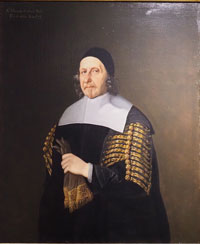
Thomas Cullum, created baronet in 1660
|
|
blank |
Thomas Cullum had been a Royalist throughout the Civil War, living and working in London. In September, 1647, he was imprisoned in the Tower of London for working in the Royalist cause. He served 6 months, being released in March, 1648.
Thomas Cullum (1587-1664) was a wealthy draper in London who had been Sheriff of London in 1646, and this portrait by Gerard Soest shows him in the robes of that office. By 1656 he was in his late 60's, and looking to retire from business. Thomas Cullum was the youngest son of John Cullum of Thorndon in Suffolk. Wishing now to become a country gentleman, he purchased the estates of Hardwick and Hawstead on the outskirts of Bury for £17,787. The Cullum family would own Hardwick House and retain a strong presence in the town and surrounds right up until 1921, when the last male heir died.
Although Hawstead Place had last been improved in 1510 by Sir Robert Drury, Thomas Cullum chose it as his country seat, and moved in in 1657.
|
|
1660
|
Living now in Hawstead Place, Thomas Cullum was knighted Baronet Hastede (ie Hawsted) in 1660 by King Charles II in recognition of his services to the Royalist cause.
|
|
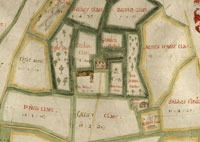
Part of Hardwick estate plan 1663
|
|
1663
|
In 1663 Thomas Covell was employed to make a map of the Hardwick estate. The central part including the main house is shown here, from the Record Office. It seems from the legend on the 1663 map that Hardwick House was leased to one James Parker at this time, while Cullum remained at Hawstead Place.
You can click on the attached thumbnail to see the whole of this plan, published online by the Bury St Edmunds Record Office.
|
|
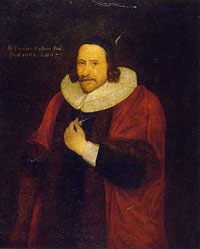
Sir Thomas Cullum, 1st baronet, d 1664
|
|
1664
|
Sir Thomas Cullum of Hawstead and Hardwick, died in 1664, worth £43,805. He had bought the estates from Sir Christopher Wray in 1656, and he originally preferred to live at Hawstead Place, but his family soon moved to make their new home at Hardwick Hall, which was a lot newer, dating only from 1612.
Hardwick House was probably on the site of the medieval Abbot's Lodge, and parts of the lodge may have been retained.
|
|
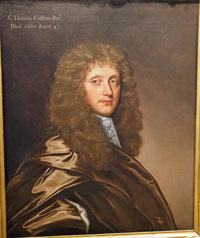
Thomas Cullum, 2nd baronet from 1664
|
|
blank |
The family estates now passed to his son, also called Sir Thomas Cullum, who was the second baronet of Hawstead. This Sir Thomas was to become known as a great gardener. He built a greenhouse measuring 58 feet long and 14 feet wide at the Hawstead property. Various descendants would continue this botanical heritage. He died in 1680 aged 47 years.
|
|
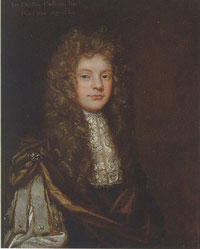
Sir Dudley Cullum 3rd baronet
|
|
1681
|
At Hardwick, Sir Dudley Cullum, the third baronet, made great additions to Hardwick House. The statue of Hercules was moved there from Hawstead Place, along with a stone porch. Like Sir Robert Drury before him, he removed treasures from Hawstead Place to liven up Hardwick House.
Sir Dudley Cullum was a botanist of note, and would become High Sheriff of Suffolk in 1690, and MP for Suffolk in 1702. On his death in 1720, the estates would pass to a cousin, Jasper Cullum of Middlesex.
|
|
1720
|
Sir Dudley Cullum had no sons to inherit the estate, and so in 1720 Hardwick and Hawstead passed to a cousin, Jasper Cullum. He now became Sir Jasper Cullum, 4th Baronet of Hawstead. Sir Jasper was High Sheriff of Suffolk in 1722, and died in November, 1754.
|
|
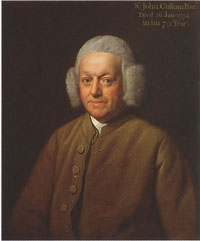
Sir John Cullum, 5th baronet
|
|
1730
|
Around 1730 John Cullum, (Sir John and the fifth baronet in 1754), of the family which had owned Hardwick and Hawstead since 1656, finally seems to have moved completely from Hawstead Place into Hardwick House. John was married to Susanna Gery, daughter of Sir Thomas Gery, and thus did Gery become a Cullum family name, surviving in usage into the twentieth century.
Hawsted Place was let to various tenants, used as a farmhouse, and reduced in size over the next 90 years, being finally demolished in 1827.
|
|
1754
|
On the death of Sir Jasper Cullum, the baronetcy and estates passed to his son, John Cullum who now became the 5th baronet Hastede (Hawstead in modern spelling).
|
|
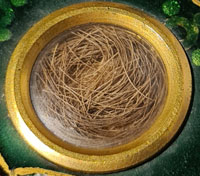
Beaufort's hair
|
|
1772
|
The following information comes from the Universal Directory of 1791:
"On 20th February 1772, workmen breaking up part of the old abbey church in Bury St Edmunds, discovered a lead coffin with the embalmed body of Thomas Beaufort, son of John of Gaunt. He had died in 1427, and was buried at the entrance to the Lady Chapel, close to the wall, on the north side of the choir. He was reburied in an oak coffin close to the north side of the large north east pillar which formerly assisted to support the Belfrey."
Dr Thomas Gery Cullum, who had a surgery in Northgate Street, examined the remains. He noted the extremely well-preserved state of the body mainly due to the high-quality embalming, layers of cere cloth and the tight-fitting lead coffin. Cullum removed its two hands, putting them into preserving fluid and sending them off to the Royal College of Surgeons museum. Cullum carried out further investigations on the body, also cutting off samples of hair, which may now be seen in Moyses Hall Museum.
|
|
1774
|
In 1774 Sir John Cullum, 5th baronet, died and was buried in Hawstead Church, aged 75.
He was succeeded as sixth baronet by his eldest son the Reverend Sir John Cullum, FRS, FSA. The Reverend Sir John is probably the best remembered of the Cullums as he was an eminent scholar, becoming a Fellow of the Royal Society and a Fellow of the Society of Antiquaries. He was appointed Rector of Hawstead in 1762, and Vicar of Great Thurlow in 1774. The Cullums seem to have had a family interest in botany, as like Sir Dudley Cullum, the 3rd baronet, the Reverend Sir John made his name in this field. His descendants would also follow on these botanical interests. His work of 1783 and 1785 is still of interest today.
|
|
1780
|
From about 1780, Sir Thomas Cullum practised surgery and medicine from Consulting Rooms in Northgate Street. Many of his remedies would seem dangerous and frightening to us today. The Cullum family lived at Hardwick House just outside Bury St Edmunds.
|
|
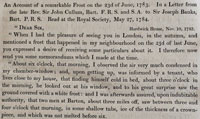
Sir John Cullum's letter
to The Royal Society Page one
|
|
1783
|
The year 1783 was notable for some unseasonal weather, not only in Britain, but across the northern hemisphere. Volcanic eruptions in Iceland, from the Laki fissure, poured large amounts of ash and dust into the atmosphere, sufficient to cut off the normal amounts of sunlight reaching parts of the earth.
|
|

Sir John Cullum's letter
Page two
|
|
blank |
There had been a severe frost on May 26th in East Anglia, damaging trees and crops, but the most severe example was a frost on 23rd June, 1783. The report prepared by the Reverend Sir John Cullum of Hardwick Hall is still studied today to show the effects that vulcanism can have across the globe. His report to the Royal Society "Of a remarkable frost on the 23rd June 1783", noted the impact on barley, oats and rye, but wheat was not much affected. Walnut trees lost all their crop. Cherries, Peaches and Hazel trees all shed their leaves,and "littered the walks as if in Autumn." Vegetables were shrivelled as if burned. However he noted that oddly, the fig and vine that grew on a wall were little affected, although fig trees in Bury were "very much cut."
|
|
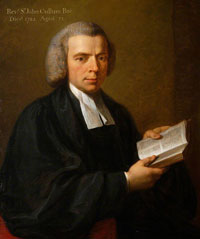
The Revd Sir John Cullum
6th baronet
|
|
1784
|
The Cullum family had owned the estates of Hardwick and Hawstead since 1656. The 6th baronet was the Reverend Sir John Cullum, Bart., FRS, FSA, (1733-85) a keen botanist and antiquarian. In 1784 he published the "History and Antiquities of Hawstead in the County of Suffolk". This book had 247 pages and four plates, and was published by J Nichols of London. It would be re-published in 1813 in a second limited edition. This work and his other botanical writings are still of interest today.
Sir John included a small section on Hardwick at the end of his book. He wrote that as it was extra parochial it would not find a place in any other parish history.
By 1784 the Jacobean painted closet, probably originally intended for the chapel at Hawstead, was removed to Hardwick House.
|
|
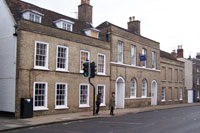
Sir Thomas Cullum's surgery
|
|
1785
|
The Reverend Sir John Cullum was married but had no children. He died in 1785, aged 53, and the estates passed to his brother, Thomas Gery Cullum FRS, FSA, FLS, (1741-1831).
|
|
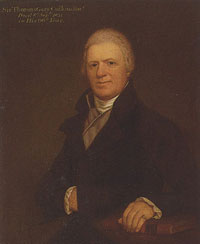
Sir Thomas Gery Cullum 7th baronet
|
|
blank |
Thomas now became Sir Thomas Gery Cullum, the 7th Baronet, (1741-1831) but he was already distinguished as a doctor and surgeon, who had a practice in Northgate Street, Bury St Edmunds. Today this address is called 113 Northgate Street or Manchester House, but at the time it would have looked very different. The house was remodelled with white brick frontage in the mid 19th century.
Upon inheriting his title and the family estates at Hawstead and Hardwick he gave up his medical practice in Bury St Edmunds.
As well as his medical knowledge, he was skilled in botany and natural history, for which he gained a national reputation in his own right. The genus Cullumia was named in his honour. This is an obscure genus of 16 plants of the compositae or daisy family, from southern Africa.
Sir Thomas Gery Cullum was also a student of genealogy and heraldry and was made Bath King of Arms.
|
|
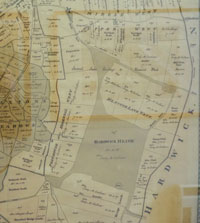
Warren 1791
|
|
1791
|
In 1791 a third edition of Thomas Warren's Map of Bury was produced. This edition showed some of the surrounding countryside and the Town Fields within the Borough boundary. Hardwick Heath is shown on this map, but other parts of the Hardwick estate outside the borough boundary are off the map. Note that the area shown here as Hardwick Heath is not the same as the public park known today as Hardwick Heath. The modern park is off this map.
The Hardwick Estate lands are labelled "Dow Lady M Cullum". Dow probably meaning Dowager. Mary Cullum (17??-1807) was the unmarried sister of the 6th and 7th baronets.
Note that Warren's map has east at the top, while the Hardwick Estate map has south at the top. This makes comparisons difficult between these two maps and between either map and modern maps which have north at the top.
|
|
1807
|
Mrs Susanna Palmer, proprietor of the Lark Navigation, was 70 years old in 1806. By 1807 it seems that her nephew, Sir Thomas Gery Cullum of Hardwick House, was managing her affairs on her behalf. These included the River Lark, and part of the Great Ouse, and he was to become an enthusiastic improver of the Navigation. Provisions of the 1795 Act included a number for improving the River Lark, and Cullum seems to have felt that it was now up to him to carry them out.
|
|
1809
|
The second decade of the 19th century would turn out to be the coldest decade in Britain since the 1690s. In his book on the History of Hawstead, written in 1784, Sir John Cullum described two types of tremendous plane trees that grew at Hawstead Place. By the time that his book was re-issued in 1813, many of these trees were dead. The occidental planes were all killed in the Autumn of 1809, or in the following Spring, while the oriental planes survived. This seems to have been the case in many parts of England.
|
|

Cullum Genealogy C15 to 1810
|
|
1813
|
In 1784 the Reverend Sir John Cullum had published his book on the history of Hawstead. In 1813 the work was re-published as "The History and Antiquities of Hawstead and Hardwick in the County of Suffolk." Sir John had died in 1785, but the new edition, which was limited to 230 copies, included his own corrections, as well as notes by his brother, Sir Thomas Gery Cullum, and 7 new plates.
Sir Thomas Gery Cullum was also managing the River Lark Navigation on behalf of his aunt, Susanna Palmer, at this time. The company assets included the Wharf at Fornham, located just downstream of the site of Babwell Priory.
Part of the Cullum family tree was included in this volume,covering some sketchy details from 1454, with more details from the 1660s Hawstead branch up to 1810 at Hardwick.
|
|
1815
|
In 1815 Sir Thomas Gery Cullum was carrying out improvements to the River Lark at Mildenhall. The Mildenhall sluice was being built at this time, but like many of Cullum's works, it is unclear whether these are rebuilds of older installations, or completely new constructions. He would continue to repair and rebuild features along the river until his death in 1831. His son, the Reverend Thomas Gery Cullum, then carried on this work into the 1840s and early 1850s. Because both men had the same name, and both were titled by way of the baronetcy, it can be difficult to sort out which man undertook which works. Sir Thomas the elder became 7th baronet in 1785, and died in 1831. The Reverend Thomas became the 8th baronet, Reverend Sir Thomas in 1831, and the title became extinct upon his death in 1855.
|
|
1827
|
Hawstead Place had gradually been demolished over the years. By 1818 only the north front remained, but in 1827-29 the main porch was removed and installed at Hardwick House. The statue of Hercules, also known as the wild man,
was similarly moved to the gardens of Hardwick House during the 1820s.
|
|
1829
|
Susanna Palmer, the proprietor of the River Lark Navigation, died in 1829, aged 93. The Lark navigation now passed into the hands of Sir Thomas Gery Cullum of Hardwick House. In practice he seems to have been managing it on her behalf for some years past.
|
|
1830
|
The Reverend Thomas Gery Cullum, vicar of Knettishall, was married to Mary Ann Eggars in 1805 and in 1830 Mary Ann died, aged about 53. Together they had one daughter, Susannah Arethusa Cullum, born in 1814. The Reverend Thomas was the eldest son of the 7th Baronet Hastede, Sir Thomas Gery Cullum.
|
|
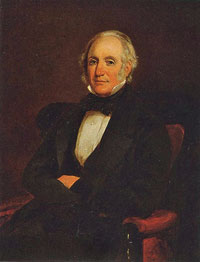
Revd Sir Thomas Gery Cullum, 8th Bart
|
|
1831
|
The 7th baronet Sir Thomas Gery Cullum, FRS, FSA, FLS, of Hardwick and Hawstead, died in 1831, aged 90, and was buried at Hawstead church. Before succeeding to the baronetcy in 1785, he had been a doctor and surgeon, practising at 113 Northgate Street, Bury St Edmunds. He had also been responsible for many improvements to the River Lark navigation, which had been badly decayed until he took over its management in about 1807.
He was succeeded as 8th baronet by his eldest son, who also shared his name. The Reverend Sir Thomas Gery Cullum, 8th baronet, also inherited his father's love of botany. He was vicar of Knettishall and chaplain to the Duke of Sussex. He would undertake some major improvements to Hardwick House and the estate, and continued to make improvements to the River Lark navigation. The Reverend Sir Thomas Gery Cullum, 8th baronet, liked to leave his mark on his achievements, and plaques with the legend "TGC 18??" can be seen on structures built by him.
The 8th baronet was only recently widowed, with a teenage daughter, Susanna Arethusa Cullum, born in 1814.
He would marry Ann Lloyd, his second wife, in 1832.
|
|
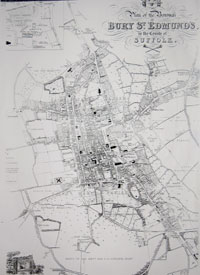
Richard Payne's Map |
|
1834
|
In 1833 Richard Payne had surveyed Bury St Edmunds and he published his new town map in 1834. The lands of Sir T G Cullum are shown within the town boundary, but the area covering Hardwick House, still known today as Hardwick Heath, is outside the Borough.
|
|

Hardwick House c1836
|
|
1836
|
This is the state of Hardwick House at the time of this engraving, which John Gage published in his work entitled "History and Antiquities of Suffolk, Thingoe Hundred" in 1838. Although it is a large mansion it would be greatly enlarged by later owners.
|
|
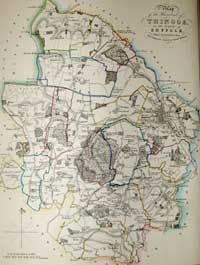
Extent of Thingoe Hundred 1838
|
|
1838
|
In 1838 John Deck of Bury published the work by John Gage entitled "History and Antiquities of Suffolk, Thingoe Hundred". This was a review of all the estates around Bury within the Hundred of Thingoe. This area contained 18 parishes and would survive as an administrative unit as Thingoe Rural District Council until 1974.
The Hardwick estate is visible as are Ickworth, Hawstead and Nowton. Hardwick House and the land of the estate to the south of the house are outlined in red, and marked on Gage's map as "extra -parochial". Usually this status allowed the inhabitants to avoid the levy of the Poor Rate, but conversely those inhabitants could not receive any parish relief. This issue does not seem to have been a problem in Hardwick because any population of this area seems to have been in the employ of the estate or otherwise cared for by it. Thus the provisions of the New Poor Law of 1834 seem to have been ignored insofar as Hardwick was concerned.
|
|
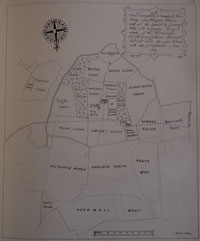
Hardwick Estate 1663 engraved 1838
|
|
blank |
One valuable plan published by John Gage in his volume "Thingoe" was this engraving of the estate plan of Hardwick, taken from the original hand drawn and painted map by Thomas Covell of 1663. Just as in the original plan, south is shown at the top of the map and north at the bottom. East is therefore on the left and west on the right.
The top portion of the plan has a dashed and dotted line which encloses the supposed extent of the "extra parochial" area of Hardwick. This area is not regarded as within any ecclesiastical jurisdiction as previous owners had obtained permission to construct a private chapel for their family, servants and occupants of the alms houses on the estate.
The 'lower' (or northern) part of the dotted line divides part of the estate from the Borough of Bury St Edmunds - St Mary's parish.
Pound Close and Causey Close can be identified on Warren's map of Bury St Edmunds of 1791, as can Hargate (Hardwick) Heath and Hockwell Went despite 128 years of time difference between the two maps.
|
|
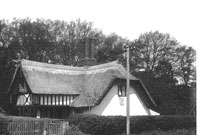
The Swiss Cottage
|
|
1839
|
The Reverend Sir Thomas Cullum, 8th baronet of Hardwick and Hawstead, also enlarged Hardwick House, adding embattlements and crenellations. His architect was Matthew Habershon, a Gothic revival enthusiast. He laid out extravagant gardens as well. In 1834 he had built the Swiss Cottage, also called Dairy Cottage, in Home Farm Lane following a trip to Switzerland. This house can still be seen today in what has now become a smart suburban street.
Sir Thomas Cullum had no sons, and neither did his brother, John Palmer Cullum. The baronetcy would become extinct in 1855, on Sir Thomas's death.
|
|
1842
|
Some of 8th baronet Sir Thomas Cullum's major improvements to the River Lark were finished in 1842. The Cherry Ground lock at Lackford was built by Sir Thomas, and once had a plaque stating "TGC 1842". This lock is now within the West Stow Country Park, and has been fenced off because the brickwork is crumbling away. It currently bears an Anglian Water sign calling it Cherry Tree Lock.
The Cherry Ground lock was a key part of the improvements to the river. It was built on a bend where the lock was fashioned into a crescent shape, much longer and wider than the usual locks on the Lark. It could hold 8 gangs of lighters at one time if necessary, lined up side by side. Such a lock justified a full time resident lock keeper.
So Sir Thomas Cullum also built River House nearby for the use of the lock keeper. This was completely demolished in 1979 as part of the preparations for the opening of the West Stow Country Park to the public. The house had stood in ruins for years, and was unsafe. According to D E Weston, this house also bore the Cullum plaque, "TGC 1842".
Cullum's investment in the river would become almost worthless when the railway arrived in 1846.
|
|
1845
|
Cullum's architect Matthew Habershon, designed substantial architectural features in the extravagant gardens behind the house.
|
|
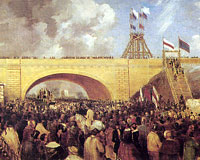
First train to Bury |
|
1846
|
Through 1846 the River Lark navigation enjoyed its last 12 months of prosperity until disaster arrived for it at Bury St Edmunds in the shape of the railway. Navigation company records show that some 10,000 tons of coal and other goods were sent from Kings Lynn to Bury St Edmunds by barge in 1845. By 1852 this trade would have dwindled to almost nothing.
In December, 1846 the long hoped for railway line arrived at Bury St Edmunds from Ipswich. There were street celebrations and fireworks to welcome this great event.
In December, 1846, when the first 90 tons of coal arrived in Bury by train, its price fell by ten percent.
|
|
1848
|
Through the 1840's the reverend Sir Thomas Gery Cullum had been running the Lark Navigation Company on behalf of his Aunt. This included the wharfage and the coalyards in Fornham Road. Perhaps Cullum could see that the railways would result in a loss of trade on the canals.
In this year the Ipswich and Suffolk Railway company agreed to pay the Reverend Sir Thomas Cullum £500 a year to let the Lark Navigation decay for ten years. The agreement started on 1st January 1849, and despite the protests of the Bury Corporation, the deal was done. The corporation's legal advice was that this was contrary to the original Navigation Act.
|
|
1850
|
In 1850 the Poor Law Board tried to address the issue of the remaining extra-parochial areas. In Suffolk the report only recorded three such areas valued for the poor rate, and included a note that said, "The Act of 8 & 9 Victoria, chapter 111, has not been acted upon in this county."
|
|
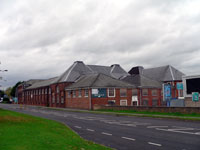
Dunnell's Maltings of 1851 |
|
1851
|
Much of the land at the Fornham Wharf had been coalyards, and most of the tonnage on the river had been coal. The Ipswich to Bury railway line had been delivering coal right into Bury St Edmunds at Northgate Street since December 1846. Thomas Ridley had rented a coal warehouse from Sir Thomas at Fornham Wharf, but he no longer required its use. Sir Thomas probably did not have the money, or the inclination, to redevelop the site himself, so he let it to Robert and John Dunnell, who built a large new Malt House on the site.
Some iron ties at the northern end of the building still display the inscription, "TGC 1851".
|
|
1855
|
White's Directory of Suffolk for 1855 noted that:
"In consequence of an arrangement between Sir T G Cullum and the Railway Company, the traffic on the Lark Navigation is now much diminished."
During this period of the sudden decline of the River Lark navigation, Sir Thomas Gery Cullum died, aged 77, on February 3rd, 1855. He had made many improvements to the river in the 1840s, but the new railways had largely destroyed the barge trade.
The Reverend Sir Thomas Cullum of Hardwick and Hawstead had no sons, and neither did his brother, John Palmer Cullum. The baronetcy would thus become extinct in 1855, on Sir Thomas's death. However, the estates passed to his daughter Arethusa, the wife of The Right Honourable Thomas Milner-Gibson. The Cullum name was later adopted by their son George Gery Milner-Gibson, (1857-1921), so he became known as George Gery Milner-Gibson Cullum. This would enable him to inherit the estate in his turn.
There was an older half-brother, Thomas Bowles, son of Thomas Milner-Gibson, but he had no claim on the Cullum estates.
Hardwick House continued to be occupied by the second wife of Sir Thomas, Lady Ann Cullum, (nee Lloyd), until her death in 1875.
|
|
1858
|
The Extra-Parochial Places Act 1857, effective from 1 January 1858 aimed to turn extra-parochial places into civil parishes, providing for poor relief, poor rates, police rates, burial, and registration. A local act could be used to join the extra-parochial area to a poor law union or parish if the guardians agreed. It was also possible for the extra-parochial place to be merged with another parish if a majority of landowners and occupiers agreed.
This Act was also partly unsuccessful and several areas continued to operate extra parochially.
|
|
1862
|
Desperate to sell the rapidly declining Lark Navigation, Lady Ann Cullum had it auctioned off in London. The Navigation was sold for £4,500, half its original build cost, to James Lee, a local coal and timber merchant. He planned to bring in coal cheaper than the railway, but first it needed a massive investment in the canal. Lee died on September 8th, 1862, before anything came of his plan.
|
|
1868
|
The Poor Law Amendment Act 1868 incorporated "for all civil parochial purposes" the extra-parochial places remaining on 25 December 1868, that were without an appointed overseer of the poor, into a neighbouring parish with the longest common boundary.
This seems to have removed from Hardwick any chance of remaining extra-parochial. By the 1880 Ordnance Survey mapping Hardwick House and the estate lands to the north of the house were incorporated within the boundary of St Mary's parish, Bury St Edmunds.
|
|
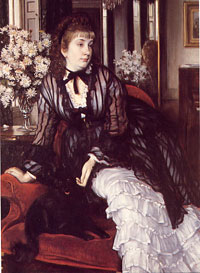
Sydney Milner-Gibson
|
|
1872
|
Sydney Isabella Milner Gibson (1849-1880) was the only daughter of the Rt. Hon. Thomas Milner Gibson and Susanna Arethusa Cullum, (1814-1885). Sydney was sister to George Gery Milner-Gibson and a granddaughter of the 8th Baronet of Hawstead, The Reverend Sir Thomas Gery Cullum.
In January 1842, Thomas Gibson Bowles was born to his father Thomas Milner Gibson and his mother, Susannah Bowles, a servant. Thus he shared a father with George Gery and Sydney Isabella, but appears to have been illegitimate.
In 1872 Sydney Isabella Milner-Gibson was 21, and she was presented with this portrait by her half brother, Thomas Gibson Bowles. At this time Bowles was the founder and publisher of "Vanity Fair", going on to found "The Lady" in 1885. Tommy Bowles knew the French painter, James Tissot, who had fled Paris in the face of the Franco-Prussian War. Bowles had given him a roof over his head in London and commissioned the portrait from him. This portrait was the most distinguished of the works of art to make up the Cullum Bequest, left to the Borough of Bury St Edmunds in the 1920's. For many years it was on display over the stairs in the Library when it occupied the site of today's Laura Ashley store. For some years it was on display in the Manor House Museum on Honey Hill, Bury St Edmunds, until that Museum closed in 2006.
|
|
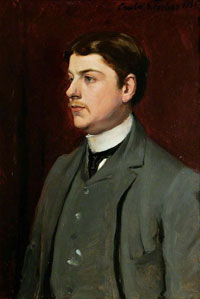
George Gery Milner-Gibson Cullum 1885
|
|
1875
|
In 1875 Lady Ann Cullum (nee Lloyd) died. She had been the second wife of the 8th Baronet, The Reverend Sir Thomas Gery Cullum. Sir Thomas's first wife had been Lady Mary Ann Cullum (nee Eggars) the mother of their only child, Susannah Arethusa Cullum. Susannah married Thomas Milner Gibson in 1832, and their only son was George Gery Milner-Gibson, born in 1857.
George was therefore the grandson of the 8th Baronet, and on the death of Lady Ann he inherited Hardwick House and changed his name to George Gery Milner-Gibson Cullum.
|
|
1888
|
George Gery Milner-Gibson Cullum, of Hardwick House became the Sheriff of Suffolk. Born in 1857, he lived for most of his life at Hardwick, just outside Bury St Edmunds, and spent his time in studying history, archaeology and genealogy. He also had a collection of autographs. He had a great influence on setting up Moyse's Hall as a local museum, and loaned many family items for display. When he died in 1921, he would leave the Cullum Bequest to the town of Bury St Edmunds, consisting of a large collection of books, objets d'arts and paintings.
|
|
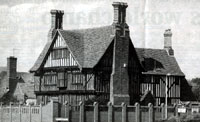
Moot Hall Clacton |
|
1910
|
During 1910, the Moot Hall at Hawstead Place was to enjoy a trip to the seaside. The 15th century hall had been built at Hawstead Place, just outside Bury St Edmunds. Two directors of the firm of Christies, Gill and Reigat, bought it, having been in use as a granary by this time, and took it to pieces, labelling each item. All the timbers, bricks and tiles were taken to Clacton by horse drawn carts, and re-assembled on the Marine Parade in Clacton. It had no staircase, and remained in use like that until stairs were installed 24 years later.
|
|
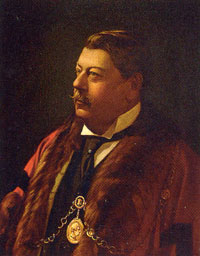
G G Milner-Gibson Cullum
|
|
1913
|
The Borough of Bury St Edmunds took the very unusual step of honouring a non-councillor by making him Mayor of the Borough. Technically he had to be honorary Mayor, and the man in question was the highly respected local antiquarian, George Gery Milner-Gibson Cullum of Hardwick Hall. He had been instrumental in the setting up of Moyse's Hall museum in the 1890s, and was also made honorary curator of Moyse's Hall in 1912, a post which he would fill for nine years, from 1912 until his death in 1921. When he died, in 1921, he left a large collection of books, pictures and other items to the Borough, collectively known as the Cullum bequest.
|
|
1914
|
Please click here if you wish to follow the story of Hardwick into the Great War and through to the eve of World War II.
|
|
Quick links on this page
Top of Page 945
R Drury buys Bokenhams-Hawsted 1463
Wm Drury gets Hencote 1553
Queen at Hawsted 1578
Drury buys Hardwick 1610
Cullum buys Hawsted and Hardwick 1656
Cullum resides Hardwick 1730
Warren's map 1791
John Gage on Thingoe 1838
|
Prepared for this St Edmundsbury website
by David Addy, 21st January, 2022
Books and other resources consulted:
"The History and Antiquities of Hawstead and Hardwick in the County of Suffolk", Revd Sir John Cullum (1784) and Sir Thomas Gery Cullum, second edition, 1813
"The History and Antiquities of Suffolk, Thingoe Hundred" by John Gage esq., FRS Dir SA, 1838
"Hardwick House", by Samuel Tymms, Proceedings of SIAH, Volume II, 1859
Excursion to Hawstead - notes by Clive Paine and Philip Aitkens, June 1990, Proceedings SIAH Volume XXXVII, part 3, 1991
"An Elizabethan Progress" by Zillah Dovey 1996
"Oil Paintings in Public Ownership in Suffolk", Public Catalogue Foundation, 2005
"Lost Country Houses of Suffolk" by W M Roberts, 2010.
Moyse's Hall Museum Picture collection
Suffolk Record Office, Bury St Edmunds
"Hawstead 2001" - Hawstead Millennium Project, editor Joan Cook
| |



































